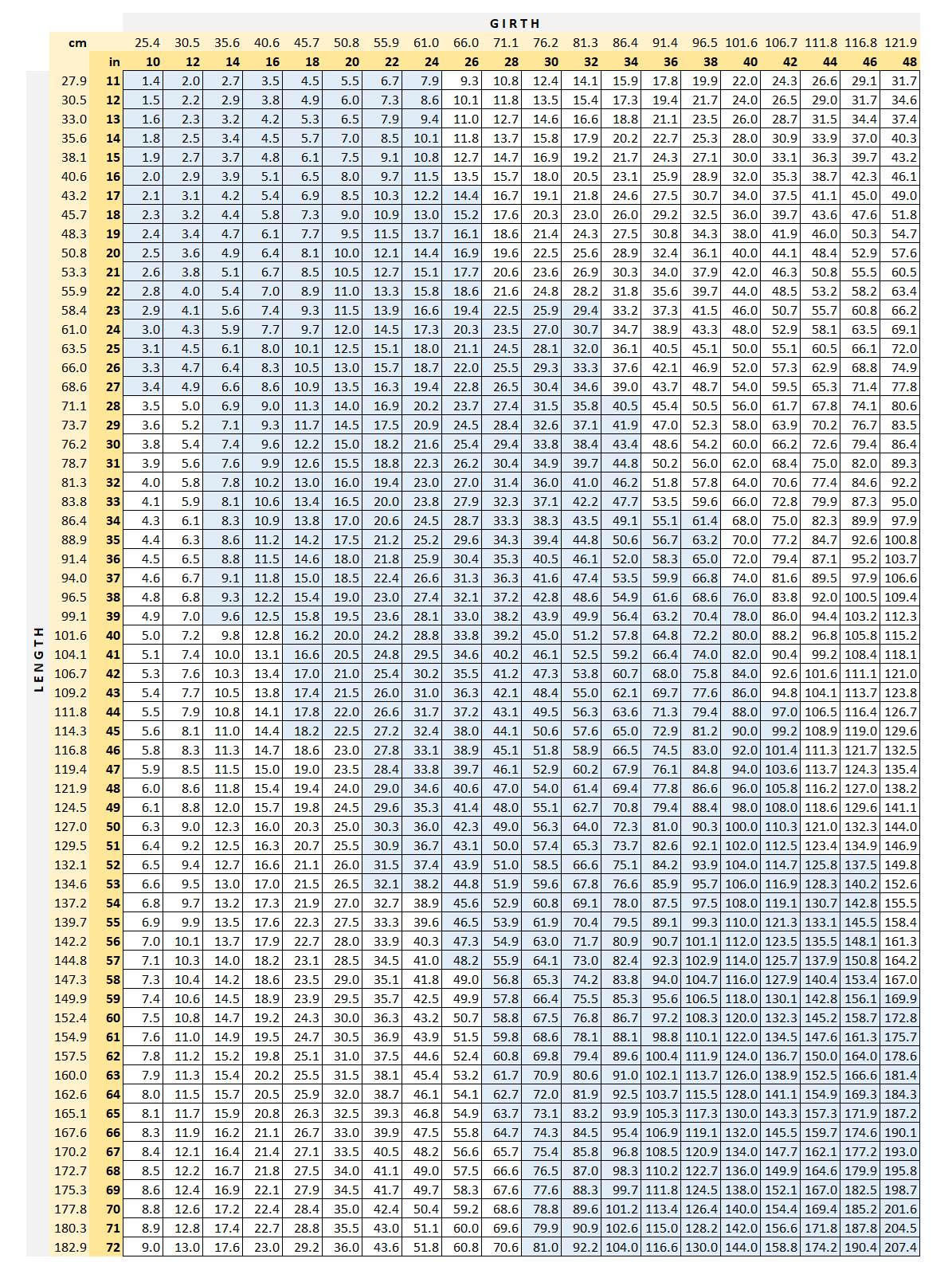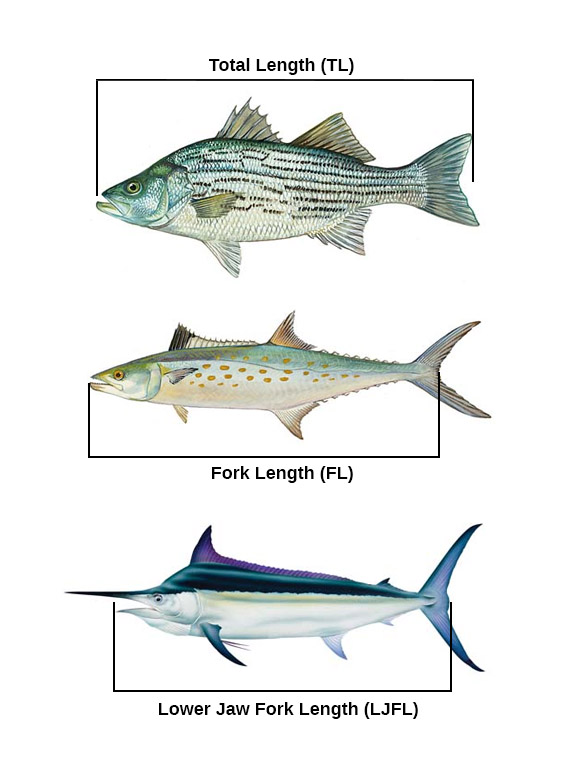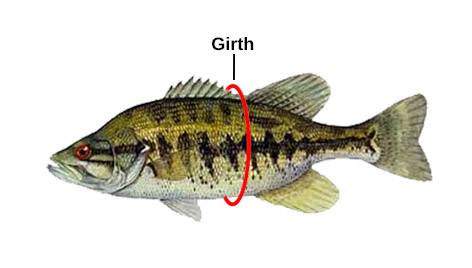There are several calculations for estimating the weight of a fish. One of the most popular—and accurate—is a function of length and girth. Another method is based purely on length. Both methods incorporate a divisor (or “shape” factor) that can be adjusted for a particular fish species, region, or body of water to provide a more accurate estimate.
Generic formulas for estimating the weight of a fish based on length and girth, simply length:
- (length x girth x girth) / 800
- (length x length x length) / 1200
Formulas for estimating weight using both length and girth tend to be most accurate because they account for how plump (or “fat”) the fish is. And as fish, even of the same species, may be more “skinny” or “fat” depending on the body of water, incorporating girth as a factor provides a more consistent and accurate estimate of weight regardless of water conditions and location.

When only length is available, estimating weight accurately may require adjusting the divisor (“shape” factor) to account for regional differences in fish size. As an example, for a bass pulled from O.H. Ivie Lake, where forage is plentiful and bass tend to be “fat”, you might use a divisor of 750. When estimating the weight of a bass out of Utah Lake, where conditions are less favorable, and bass are “skinny”, a divisor of 800 will provide a more accurate weight estimate.
However, even weight formulas incorporating girth don’t account for differences in shape across different fish species. While a bonefish and mackerel may have the same girth, they have inherently different body shapes. This impacts their relative girth to length to weight ratio. Finding the right divisor for (“shape” factor) may necessary, even when using formulas that incorporate girth.
The following charts provide length to weight (in lbs) formulas for the most common freshwater and saltwater fish species, along with average length, average weight and maximum size data for adult specimens. The most common “shape” factor for “girth” formulas is 800. It also tends to be the most accurate across species. The most common “shape” factor for “length” formuls is 1200, but I have not found it to provide consistently accurate weight estimates across species.
All divisors (“shape” factors) presented below have been tested against verified length to weight species tables to ensure accuracy across species, as well as consistency across weight groups within species. You can expect that actual fish weight may variety between 3-5% from estimated weight. Remember, these are just formulas. They produce weight estimates along a linear plane. For many fish species, the relationship between length and weight runs along a curve, so formulas for estimating weight for some fish species may not work as well for very small, or very large specimens.
Length and weight chart including average length, average weight, maximum size and weight estimation formulas for popular freshwater gamefish species.
| Length to weight (lbs) calculations | Avg length | Avg weight | Max size | |
|---|---|---|---|---|
| Largemouth Bass | (length x length x length) / 1,600 (length x length x girth) / 1,200 (length x girth x girth) / 800 | 13-16 in | 1-5 lbs | 24 in; 22 lbs |
| Smallmouth Bass | (length x girth x girth) / 850 | 10-14 in | 2-3 lbs | 27 in; 12 lbs |
| Striped Bass (Atlantic) | (length x length x length) / 1,950 (length x length x girth) / 1,200 (length x girth x girth) / 800 | 24-36 in | 20-40 lbs | 54 in; 81 lbs |
| Brown Trout | (length x girth x girth) / 730 | 15-22 in | 1-5 lbs | 27 in; 44 lbs |
| Rainbow Trout | (length x girth x girth) / 750 | 11-18 in | 1-5 lbs | 37 in; 48 lbs |
| Dolly Varden | (length x girth x girth) / 750 | 16-22 in | 1-4 lbs | 40 in; 32 lbs |
| Brook Trout | (length x girth x girth) / 800 | 6-15 in | 1-5 lbs | 31.5 in; 14.5 lbs |
| Lake Trout | (length x girth x girth) / 800 | 24-26 in | 5-15 lbs | 50 in; 102 lbs |
| Steelhead | (length x girth x girth) / 700 | 20-30 in | 4-10 lbs | 41 in; 42 lbs |
| Walleye | (length x length x length) / 2,700 (length x girth x girth) / 750 | 15-17 in | 5-15 lbs | 41 in; 35 lbs |
| Northern Pike | (length x length x length) / 3,500 (length x girth x girth) / 900 | 16-22 in | 1-3 lbs | 60 in; 60 lbs |
| Muskellunge | (length x girth x girth) / 900 | 28-36 in | 8-20 lbs | 60.25 in; 69 lbs |
| Sunfish | (length x length x length) / 1,200 | 5-12 in | 1/2-2 lbs | 14 in; 13 lbs |
| Crappie | (length x length x length) / 1,600 | 4-11 in | 1/2-1 1/2 lbs | 17 in; 5 lbs |
| Bluegill | (length x length x length) / 1,200 (length x girth x girth) / 1,200 | 5-10 in | 1-2 lbs | 15 in; 4.5 lbs |
| Yellow Perch | (length x length x length) / 2,200 | 4-10 in | 1/2-1 1/2 lbs | 20 in; 4.2 lbs |
| Channel Catfish | (length x length x girth) / 1,275 (length x girth x girth) / 850 | 12-24 in | 2-4 lbs | 47 in; 58 lbs |
| Flathead Catfish | (length x length x girth) / 1,275 (length x girth x girth) / 850 | 15-45 in | 20-30 lbs | 60 in; 120 lbs |
| Blue Catfish | (length x length x girth) / 1,200 (length x girth x girth) / 800 | 25-45 in | 30-70 lbs | 65 in; 165 lbs |
| Lake Sturgeon | (length x girth x girth) / 1075 | 48-60 in | 30-80 lbs | 84 in; 300 lbs |
| Chinook (King) Salmon | (length x girth x girth) / 740 | 22-32 in | 20-30 lbs | 41 in; 97 lbs |
| Coho (Silver) Salmon | (length x girth x girth) / 790 | 22-30 in | 8-12 lbs | 34 in; 31 lbs |
| Sockeye Salmon | (length x girth x girth) / 800 | 18-30 in | 5-15 lbs | 31 in; 16 lbs |
| Pink Salmon | (length x girth x girth) / 800 | 14-18 in | 3-5 lbs | 30 in; 15 lbs |
| Chum Salmon | ** | 22-26 in | 8-15 lbs | 42 in; 45 lbs |
** denotes that weight formulas have not been tested and (length x girth x girth) / 800 is recommended.
Length and weight chart including average length, average weight, maximum size and weight estimation formulas for popular saltwater gamefish species.
| Length to weight (lbs) calculations | Avg length | Avg weight | Max size | |
|---|---|---|---|---|
| Atlantic Salmon | ** | 26-30 in | 6-15 lbs | 63 in; 109 lbs |
| Halibut (Pacific) | (length x length x length) / 2500 (length x girth x girth) / 625 | 30-35 in | 30-40 lbs | 105 in; 500 lbs |
| Halibut (Atlantics) | ** | 52-70 in | 50-150 lbs | 180 in; 700 lbs |
| Flounder (average) | (length x length x length) / 2500 | 10-24 in | 3-15 lbs | 36 in; 22 lbs |
| Gag Grouper | (length x length x girth) / 1200 ** | 36 in | 5-20 lbs | 48 in; 80 lbs |
| Black Grouper | ** | 24 in | 10-25 lbs | 60 in; 180 lbs |
| Warsaw Grouper | ** | 30-50 in | 25-75 lbs | 82 in; 435 lbs |
| Goliath Grouper | ** | 35-85 in | 100-300 lbs | 96 in; 800 lbs |
| Bluefin Tuna | (length x length x length) / 1500 (length x girth x girth) / 800 | 30-80 in | 60-300 lbs | 144 in; 1490 lbs |
| Yellowfin Tuna | (length x length x length) / 1600 (length x girth x girth) / 800 | 35-45 in | 25-60 lbs | 100 in; 480 lbs |
| Redfish (Red Drum) | (length x girth x girth) / 900 | 25-40 in | 40 lbs | 50 in; 94 lbs |
| Corbina | (length x girth x girth) / 900 | |||
| Sheepshead | (length x length x length) / 1200 | 12-26 in | 5-15 lbs | 30 in; 25 lbs |
| Seatrout | (length x length x length) / 2200 | |||
| Black Drum | ** | 20-25 in | 20-30 lbs | 48 in; 110 lbs |
| Kingfish | (length x girth x girth) / 1140 | 10-14 in | 4-20 lbs | 70 in; 90 lbs |
| Black Seabass | (length x length x girth) / 1200 (length x girth x girth) / 800 | 12-18 in | 9 lbs | 26 in; 10 lbs |
| Bluefish | (length x girth x girth) / 900 | 15-24 in | 3-5 lbs | 48 in; 31 lbs |
| Blue Marlin | (length x girth x girth) / 750 | 66-168 in | 100-300 lbs | 192 in; 1800 lbs |
| White Marlin | (length x girth x girth) / 1300 | 50-80 in | 45-65 lbs | 110 in; 180 lbs |
| Striped Marlin | (length x girth x girth) / 950 | 108 in | 50-100 lbs | 144 in; 450 lbs |
| Black Marlin | (length x girth x girth) / 700 | 132 in | 200-400 lbs | 175 in; 1560 lbs |
| North Atlantic Sailfish | (length x girth x girth) / 1500 | 72-90 in | 50 lbs | 124 in; 142 lbs |
| North Atlantic Spearfish | (length x girth x girth) / 1500 | 50-70 in | 20-40 lbs | 90 in; 115 lbs |
| Atlantic Swordfish | (length x girth x girth) / 840 | 50-75 in | 50-200 lbs | 177 in; 1400 lbs |
| Tarpon | ((length x girth x girth) / 800) * 1.13 | 48-72 in | 50-100 lbs | 96 in; 280 lbs |
| Permit | ** | 24-36 in | 15-20 lbs | 48 in; 60 lbs |
| Bonefish | (length x length x length) / 3000 (length x girth x girth) / 900 (girth^4)*(fork length) / 800 | 16-18 in | 6-8 lbs | 36 in; 15 lbs |
| Wahoo | (length x length x length) / 3800 (length x girth x girth) / 800 | 36-60 in | 15-40 lbs | 96 in; 160 lbs |
| Red Snapper | (length x length x girth) / 1200 (length x girth x girth) / 800 | 12-24 in | 2-4 lbs | 40 in; 40 lbs |
| Mahi Mahi | ** | 30-40 in | 15-30 lbs | 84 in; 88 lbs |
| Cravalle Jack | ** | 25 in | 2-5 lbs | 50 lbs |
| Giant Trevally | (length x girth x girth) / 600 | 66-70 in | 50-60 lbs | 70 in; 176 lbs |
| Cobia | (length x girth x girth) / 800 | 35-50 in | 10-50 lbs | 72 in; 140 lbs |
| Greater Amberjack | (length x length x length) / 2900 (length x girth x girth) / 800 | 30-50 in | 20-40 lbs | 75 in; 200 lbs |
| Florida Pompano | (length x length x length) / 2500 | 15-18 in | 2-5 lbs | 26 in; 9 lbs |
| Barracuda | (length x length x length) / 4300 | 24-39 in | 5-20 lbs | 58 in; 50 lbs |
| Croaker | (length x girth x girth) / 900 | 12-18 in | 1/2-2 lbs | 27 in; 9 lbs |
| Common Snook | (length x girth x girth) / 900 | 15-30 in | 48 in; 38 lbs | |
| Atlantic Mackerel | (length x girth x girth) / 900 | 12-16 in | 1-2 lbs | 24 in; 7 lbs |
| Spanish Mackerel | (length x girth x girth) / 900 | 14-18 in | 1-3 lbs | 37 in; 13 lbs |
| Blacktip Shark | ** | 40-60 in | 40-60 lbs | 84 in; 200 lbs |
| Spinner Shark | ** | 60-72 in | 90-100 lbs | 110 in; 200 lbs |
| Blue Shark | ** | 70-90 in | 65-110 lbs | 150 in; 250 lbs |
| Bonnethead Shark | ** | 32-36 in | 3-10 lbs | 48 in; 24 lbs |
| Longfin Mako Shark | ** | 80-100 in | 150-300 lbs | 168 in; 1100 lbs |
| Shortfin Mako Shark | ** | 100-120 in | 130-300 lbs | 144 in; 1300 lbs |
| Porbeagle Shark | ** | 60-70 in | 300 lbs | 144 in; 500 llbs |
| Great Hammerhead Shark | ** | 144-216 in | 400-500 lbs | 180 in; 990 lbs |
| Bull Shark | ** | 84-132in | 200-500 lbs | 156 in; 700 lbs |
| Tiger Shark | ** | 120-168 in | 850-1400 lbs | 216 in; 1900 lbs |
| Lemon Shark | ** | 96 in | 180-200 lbs | 120 in; 550 lbs |
| Nurse Shark | ** | 84-108 in | 165-230 lbs | 120 in; 260 lbs |
| Thresher Shark | ** | 96-178 in | 330-360 lbs | 240 in; 750 lbs |
| Tope Shark | ** | 48-60 in | 20-40 lbs | 72 in; 98 lbs |
** denotes that weight formulas have not been tested and (length x girth x girth) / 800 is recommended.
Measuring Fish Length
Estimating a fish’s weight requires accurate length measurements. There are three important length measurements for determining fish length: Total length (TL), Fork Length (FL) and Lower Jaw Fork Length (LJFL).

Total length (TL) is used for estimating the weight of most fish species. Total length is determined by measuring the distance from the tip of the nose to the tip of the tail.
Total length (TL) species: trout, bass, panfish, catfish, salmon, pike, snapper, grouper, snook, drum, seatrout, weakfish, bonefish, flounder, sheepshead, etc.
Fork Length (FL) is used for estimating weight for certain saltwater fish species, such as tarpon and sharks. Fork length is determined by measuring the distance from the nose to the fork in the tail.
Fork length (FL) species: mackerel, amberjacks, permit, pompano, bluefish, mullet, cobia, rudderfish, mahi mahi, hogfish, mullet, tuna
Lower jaw fork length (LJFL) is used for estimating weight for billfish, such as sailfish and marlin. LJFL is determined by measuring the distance from the tip of the lower jaw to the fork in the tail.
LJFL species: sailfish, swordfish, marlin, spearfish
Measuring Fish Girth
Estimating a fish’s weight requires accurate girth measurements. Girth is determined by measuring the circumference at the thickest portion of a fish’s midsection.

Additional Notes
From my experience standard length-to-weight formulas have a tendency to over estimate the weight of actual fish populations. They typically represent a fish that is well fed and “above average”. Without adjusting the divisor (“shape” factor) in the formulas presented, you can assume that for every 10 fish you catch about 4 of them will be slightly above the estimated weight, and 6 below.
For the (length x length x length) / divisor formulas, the divisor (“shape” factor) was determined by calculating estimated fish weights in increments of 1 pound across all relevant weight classes for a species and coorelating the estimate with standard length-weight species tables generated using a statistically signficant sample size.



